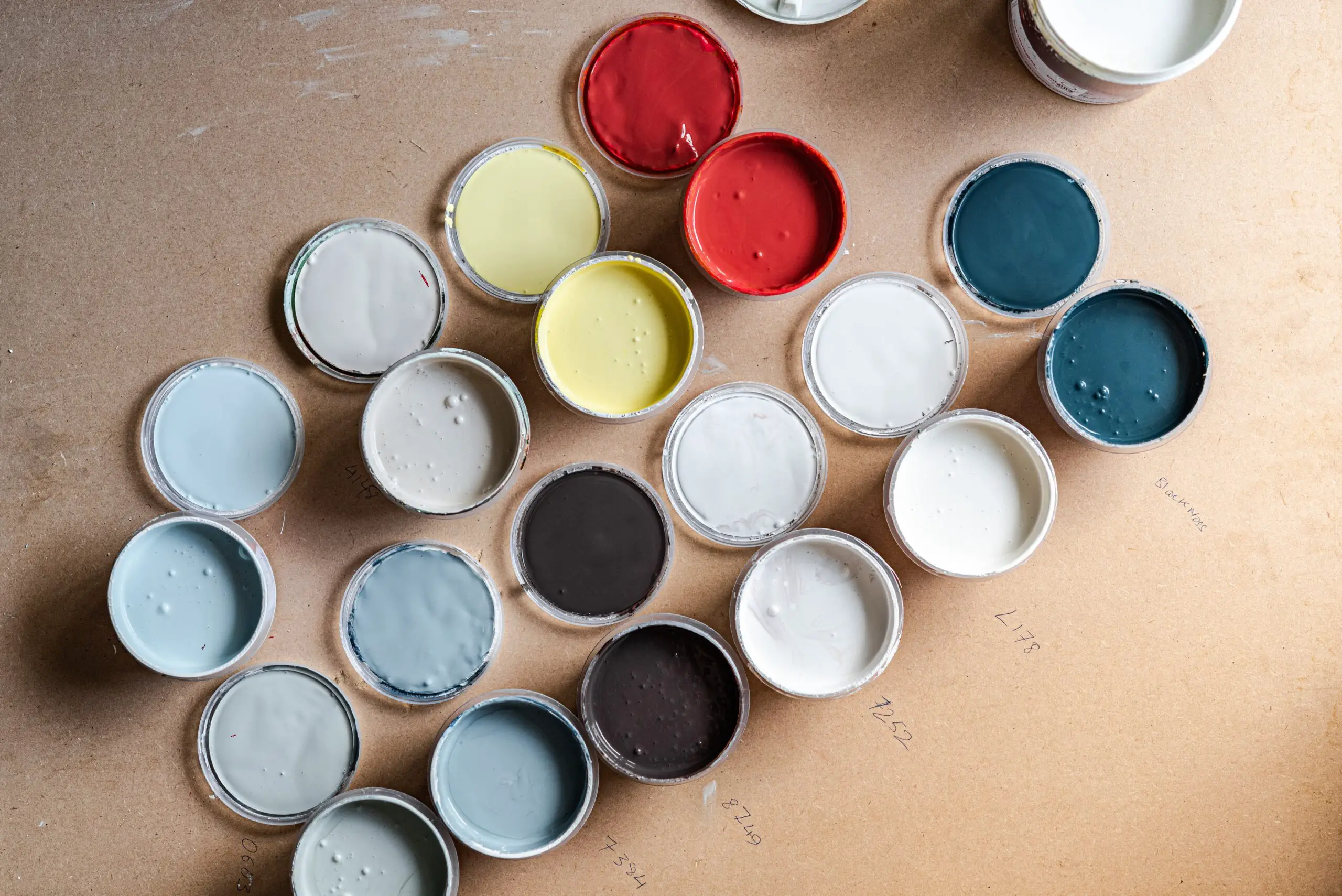At some point in your art journey, you might wonder if you could use wall paints or house paints for artwork instead of acrylic paint. To answer this question, I researched on the internet, asked artists who have used house paints for art, and even contacted manufacturers for their expertise. Here is what I have found.
In general, you can use wall paint or house paint for artwork usually on a rigid surface. You can mix light color house paint with artist acrylic paint to increase the archival quality. Artists in the past from Pablo Picasso to Jackson Pollock have used house paints in their artwork.
Art is very versatile and there are no hard and fast rules to follow. You can use anything to create art either artist acrylic paint or house paints. However, there are a few things you need to keep in mind when going for some nontraditional art mediums to make your artwork look its best.
Can you use wall paint/ house paint for art?
You can use house paint or wall paint in your artwork depending on the final finish you want with the painting. If you want an even, flat finish of colors that has an economical approach, it would be best to use good quality house paint in your paintings.
However, making art is not the intended purpose of house paints. House paints are generally used on walls and other surfaces of the house where repainting would be done every 3 to 5 years. So it has no guarantee that house paint would last for many decades or centuries to come.
There is a difference between house paint and artist acrylic paint in their characteristic depending on why they are made and to whom they are tailored. Even though good quality house paint has worked for many other artists and they have lasted for many decades, you need to remember not to expect things from house paints that house paint is not made for.
Difference between house paint and artist acrylic paint
Acrylic house paints are specifically made to paint on rigid surfaces like dry walls, concrete, wood, etc, as they are less flexible. Artist acrylic paints are more flexible and they can be painted on flexible surfaces like canvas as well as on rigid surfaces. Artist acrylics are expensive while house paints are cheaper.
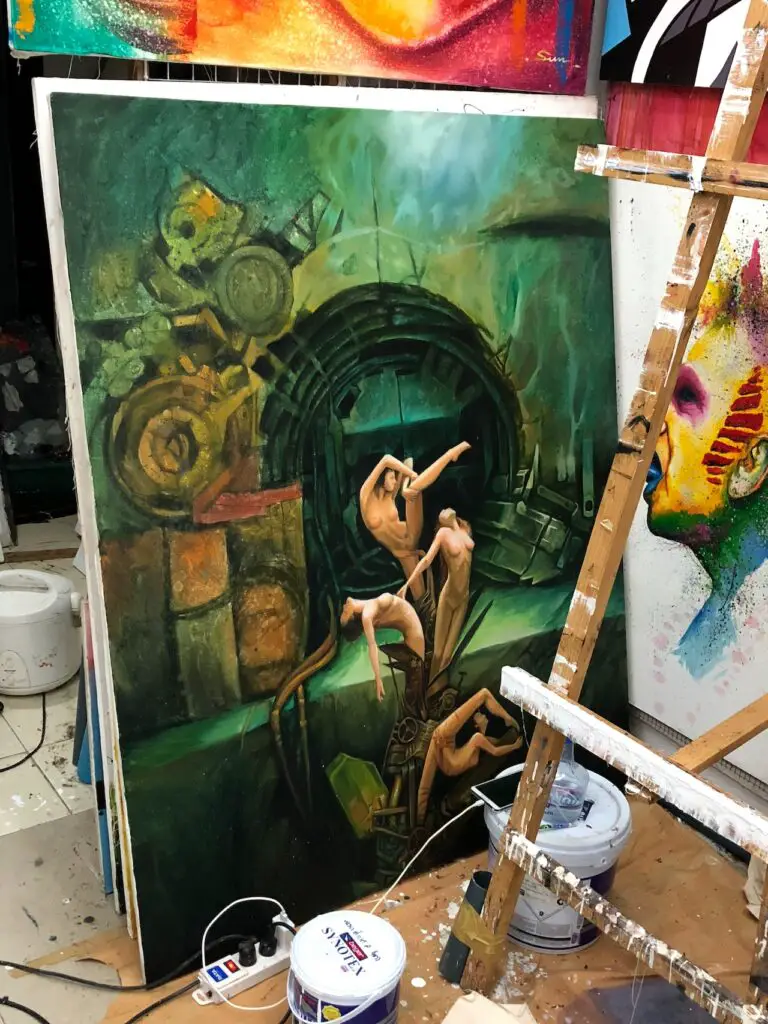
Artist acrylic paints are also loaded with pigments while house paints have fewer pigments and are mostly made from fillers and even fewer acrylic binders than, artist acrylics. That is why house paints are less flexible and artist acrylics are more flexible. The less pigment there is, the intensity and color saturation will also be lower. However, house paints provide smooth even coverage of color.
There are different types of house paints. The main types we use today are acrylic and latex house paints. Acrylic house paints come as 100% acrylics. Acrylics are the type of binder that binds all components of acrylic paint together. Latex paints are originally made by using latex rubber.
But today most latex paints also use acrylic polymer binders like Vinyl Acrylic, Polyvinyl Acrylic, and Styrene Acrylic. But if acrylic paint is used 100% it is called 100% acrylic paint. Also, it is recommended to repaint walls every 3 to 5 years because the colors can fade or wear out over time.
Artists’ acrylic paints are specially made to create archival quality artwork. They are made from lightfast pigment that can last for many decades and even a century. However, there are different qualities of artist acrylic paints.
Professional acrylic paint has the highest quality and archival nature. It has more vibrant colors and is also the most expensive of all. Student grade and craft quality paints are lower in quality, have less vibrant colors, and may even have low archival quality but are less expensive.
Where to get house paint for artwork?
You can get house paints from the local hardware store, Walmart, Home Depot, and Lows. To save more bucks get the sample pots or test pots. You will also find pots of house paints called miss tints. These are the paints that were mixed by the retailer for a customer. But when a customer does not like the mixed color they will sell them separately as miss tints for a cheaper price.
There can even be some sales or yard sales where you can buy these house paints, for a cheaper price than their regular price. As said before these small tester cans of paints are less expensive than artist acrylic paints. The small-sized tester cans are available for up to 5 liters in a vast range of colors.
However, always consider getting a good quality house paint brand even if you buy them as samplers. You can transfer these house paints that you get into clear containers or mason jars that provide an airtight seal. This way you can keep these house paints for a long time without drying.
Why do artists use house paints for artwork?
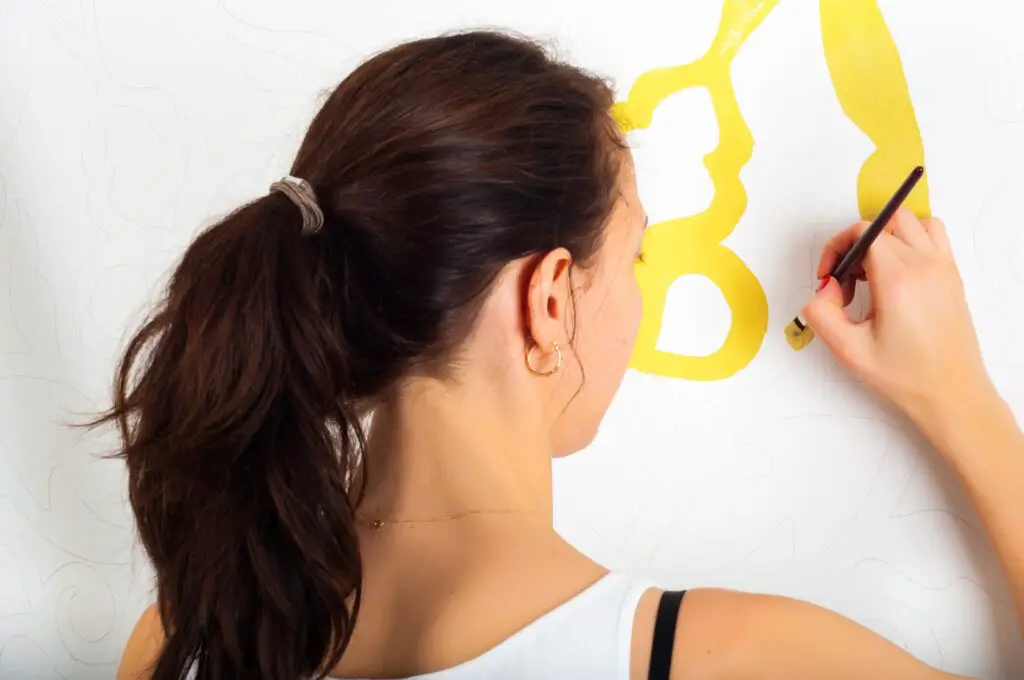
So you might ask why artists use house paints when there are artist acrylic paints at different price points. Usually, artist use house paints for economical reasons. Usually, when they have to paint larger areas or blocks of colors, they use house paints.
Behr White Flat Latex Interior/Exterior Paint which is a good quality house paint cost 0.21 USD/ fl oz. Acrylic paint used by artists costs 0.25 USD/ fl oz to 9 USD/ fl oz. You can get either house paint or craft acrylic paint at the lower end of the price spectrum for 0.2 USD/ fl oz
Also, beginner artists can start with house paints, if they can not afford artist acrylics. You can paint on rigid surfaces as it is intended, rather than on flexible surfaces like a canvas. The sample or tester posts are the most economical.
Also, house paints are a cheaper solution where you can get solid, flat, and even finish with paints. Of course, there are paint lines like SoFlat by Golden paints (3.56 USD/ fl oz to 7.80 USD/ fl oz) or Golden self-leveling acrylic mediums (10.91 USD/ 8 oz) you can use to get the same effect, but they are not economical as house paints.
Some contemporary artists (artists of today’s world) love to use house paints in their abstract, pop, or impressionist artwork. Some artists even use paint applicators like rollers to apply household emulsion paints, just like a house painter or a decorator.
Problems of using house paint in art
The main problem that arises among artists when it comes to house paint is the quality of the end product. House paint may be prone to fade away with frequent sun exposure, degradation of the paint film (chalking), yellowing in patches over time (usually in white paint), and the paint film could flake, peel and crack.
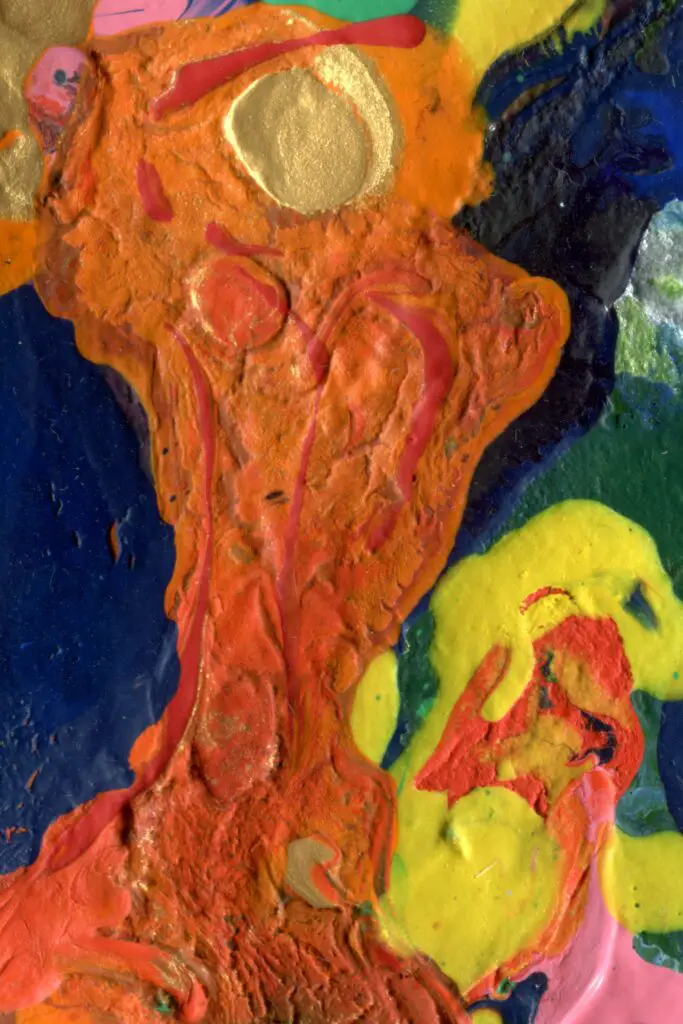
All of these house paint problems depend on the quality of the house paint and its compatibility with other paints used. Most of the time if you use good quality house paint on a rigid surface, in thin layers, most probably house paint would last long for decades to come. It would not crack at all.
Another caveat of using house paints is the less pigmentation. But if you use high-quality, top-notch house paints have an Impressive amount of pigments in them. However, you can use highly pigmented professional artist acrylic paints to give color or pigments to house paint or wall paints.
Also, subtle color mixing, blending, and glazing of house paints are much more difficult compared to artist acrylic paint. This is because house paints are not made for this purpose.
Also, house paints or emulsion paints are a bit harder on normal artist brushes. Because the paint itself is quite abrasive. So, you will need to use separate brushes for house paints.
The archival quality of house paint over artist acrylic paint
The most controversy about using house paints in artwork comes down to their archival quality. However, most artists have seen that their artwork done with house paints have preserved for many decades. But some artists suggest that house paint would not last for decades or centuries as it is not the intended use of house paints.

House paints are intended to be painted on walls or other surfaces of the house where repainting is required every 3 to 5 years. Modern, high-quality wall paints applied with proper surface preparation can last from 5 to 10 years.
On the other hand, artist acrylic paints have undergone many tests to verify their lightfastness (ability to resist fading when exposed to light). Manufacturers have made artist acrylic paint last the absolute longest without changing their colors, as it is the intended purpose of artist acrylics. However, if you use student grade or craft quality acrylic paints the lightfastness will be lower, meaning it will not withstand greatly the test of time.
You can ensure the archival quality of acrylic house paint in your artwork by choosing a good quality house paint. Even if you get the sample or tester pots look for a good house paint brand like Behr. Dulux is also a paint brand that could last longer. It is one of my personal favorites.
A good quality house paint or an emulsion paint is quick-drying and retains the color strength even outdoors. If using house paint outside choose a weather-resistant paint made for exterior use.
If you are worried about the longevity of the house paint colors indoors or outdoors, you can apply a UV-resistant, water-based varnish like acrylic varnish or polyurethane varnish on top.
You can also use colors of house paints that are long-lasting. Usually, light colors tend to absorb less heat and UV radiation. Also, bright reds, blues, and yellows are vulnerable to UV radiation. Therefore use light, muted colors of house paints. You can even mix them with artist acrylics to get long-lasting brighter colors.
If you are in doubt about the archival quality or the longevity of acrylic house paints, you can go to the manufacturer for that information. Ask for the lightfastness rating of the pigments used in the house paints. Usually, there is a technical support section on the manufacturer’s website. They are the ones who have tested the paint and know the best of their paints.
I once used latex paints to paint a landscape on a concrete wall 22 years ago, and it still exists now, still looks the same, maybe because it was indoor and moisture didn’t ruin it.
Artist on Facebook
If longevity is your absolute concern, the best option would be using professional artist acrylics which are designed and tested for a specific purpose. A good archival quality artist’s acrylic paint would have a lightfastness rating of I (excellent lightfastness) or II (good lightfastness) according to ASTM (American Society for Testing and Materials) standards.
Techniques used with house paint in art
There are some specific techniques artists love to use with house paints. It is mostly used when flat and even geometric blocks of colors are needed. Usually will be used on mural art. You can spray, brush, and even rag to produce faux finishing to the artwork is possible.
I have seen some artists use house paints in their acrylic pour art. Acrylic pours require a lot of paint and it is expensive to use all student-grade or artist-grade acrylic paint. So artists have tried using house paints usually in white color as the base of the acrylic pour.
Using house paints as the base can go wrong in many ways. It is either a hit or a miss. The more flexible or higher the quality of paint, the better the results would be. Otherwise, there is a risk of paint cracking as house paints are not flexible with movement and temperature changes.
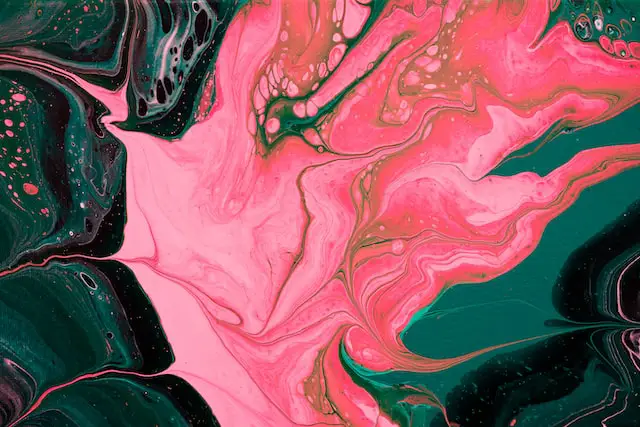
So for acrylic pours what I recommend is a good quality student-grade acrylic paint, as they can be used in large quantities more economically.
If you are a muralist Golden has developed a mural paint line called Golden Paint Mural & Theme Paints which is a 100% acrylic waterborne formulation. They are suitable for both interior and exterior artwork and can be diluted with water or acrylic mediums.
House paints can be used in different abstract art techniques. Some artists have dipped a large paintbrush in house paint and then held it up and over the canvas to create a drip-down effect on canvas. One of the best examples is Jackson Pollock’s artwork.
Can you mix house paint with artist acrylics?
Some artists have taken this approach of using both house paints and artist acrylic paint in their artwork. They usually use light pale colors of house paints or white house paint itself, to mix with a smaller amount of brighter vibrant colors of artist-grade acrylic paint.
If you use professional artist-grade acrylics, it usually comes with a load of lightfast pigments. So when you mix these lightfast pigments with house paint you will get a bright and vibrant house paint color that will last longer.
The house paint usually acrylic or the emulsion paints is used as fillers or bulking agents. Professional artist-grade acrylics are used to give lightfast color pigment/ colors to the paint. This will make an economical batch of paint that you can use for a long time and on many surfaces including flexible surfaces like canvas.
You can store these mixed batches of house paints in an airtight container. Use mason jars. You can paint a swatch of the house paint color inside, on top of the lid to easily recognize it.
Surfaces used for house paint artwork
House paints work best on rigid surfaces like drywall, concrete, hardboard, MDF, plywood, etc, which are inflexible. Painting house paints or wall paint directly on the flexible surface like canvases is not recommended as house paints are not designed to be flexible and they could crack.
However, there is a workaround for this. You could mix house paints with artist acrylic paint or acrylic mediums to improve flexibility. Both would mix nicely as most house or latex paints are also 100% acrylic.
As house paints are just like acrylic gesso primer, chalky and flat, you might think of using it instead of gesso. But it will not make your artwork last longer. Because house paint cannot withstand more temperature or humidity fluctuations and movement like acrylic gesso. This way you will not be able to make a sound and durable painting as the painting could crack.
Although priming a flexible surface with house paint on a canvas is not a good idea, you could prime a rigid surface like dry walls or timber as they are inflexible surfaces. These house paint artwork could last for decades. Some artists even use house paint on good quality paper with a high gsm value like 300 gsm.
Professional artists who used house paint in their artwork
Many professional artists both in the past and the present have used house paints in their artwork. Artists in the past who have used house paints are Jackson Pollock and Pablo Picasso. Artists who use house paint today are John Myatt, Gary Hume, Sarah Morris, Mose T, and Damien Hirst.
Jackson Pollock is an artist who is a follower of the abstract expressionist movement. He used a drip technique where he poured or splashed household paint onto the horizontal painting surface. The world-famous Picasso even used inexpensive house paints called Ripolin in his paintings. He is one of the first artists to use house paint for artwork.
It is so much better if we can consider the archival quality of a painting as much as creating art. Otherwise, you would be mentioned in history books as someone who used fugitive materials to make art. This does not mean that house paint would change or fade over time, but we do not have a guarantee either like professional artists’ acrylic paint.
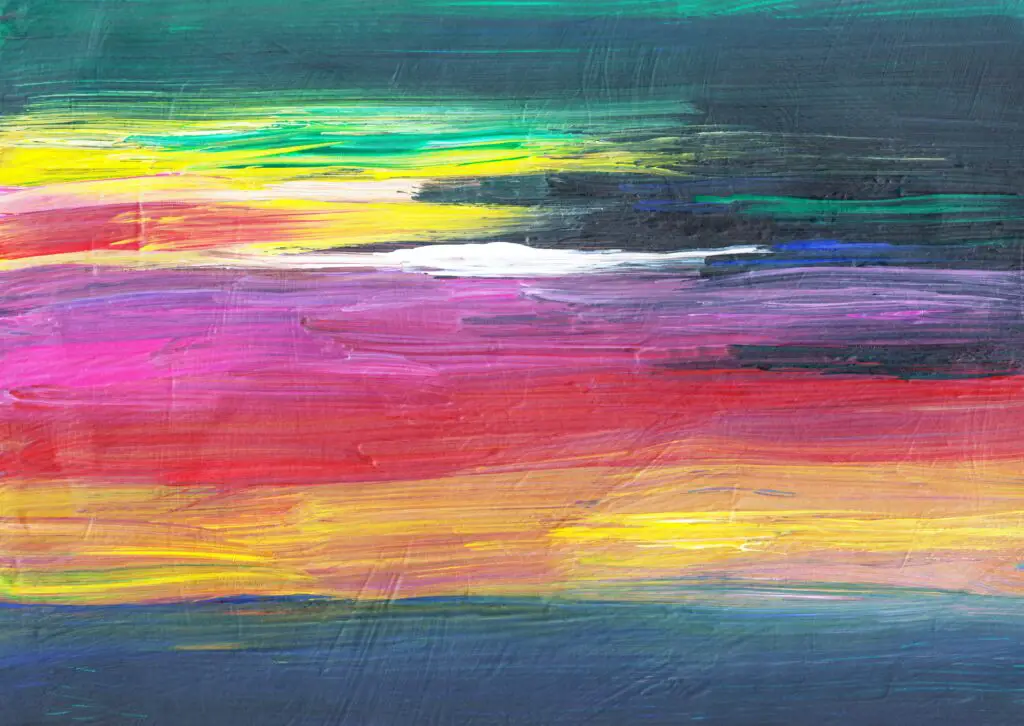
They say that Jackson Pollock was a frequent user of house paints and some of his paintings are not lasting very well. Even Jackson Pollock’s art has been cracked but is still well preserved by the conservators (source).
However in the modern world today there are a few amazing artists who use house paints regularly in their paintings. Mural Joe is an amazing mural artist. He used water-based acrylic wall paints in his paintings. If you are a mural artist there is almost no way that you can use professional acrylic paint in larger areas, as they will be used up pretty quickly and the paints are expensive.
If that is the case best thing is to find water-based acrylic wall paint colors with higher color intensity. Teddiparkerart on Instagram is another amazing artist who uses house paints. She uses house paints because she loves the effect produced by them and she could keep the prices affordable for everyone.
I have written a whole article comparing all the water-based paints to acrylic paint. You can find a detailed comparison of each water-based paint and acrylic paint including a nice summary with a handy chart.
Conclusion
When it comes to art there is no right or wrong way to make it. It is up to you to decide how you want your artwork to look and choose the painting medium that is best for the purpose. However, if you are thinking about the longevity of the artwork for many decades or centuries it is best to go for an artist medium that could do exactly that rather than using house paint as an economical solution with less archival quality.

